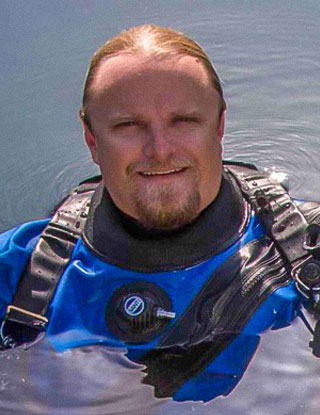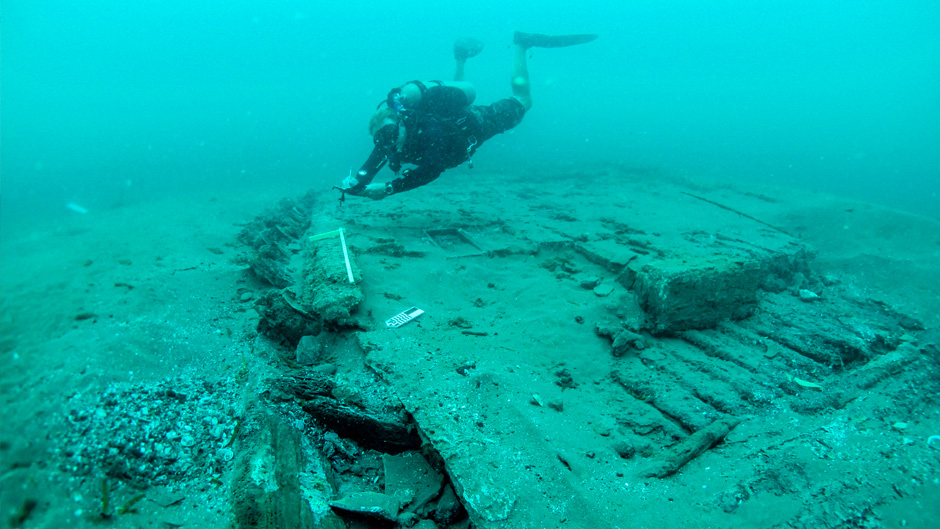Frederick Hanselmann, a senior lecturer with the University of Miami Rosenstiel School of Marine, Atmospheric, and Earth Science, presented “Real Pirates of the Caribbean: The Search for and Study of Shipwrecks from Captain Morgan and Captain Kidd!” to a full audience on Jan. 24 in the school auditorium.
In his presentation that charted the exploits and misadventures of two of the most notorious pirates to sail the Spanish Main, Hanselmann highlighted the role of the archeologist in unearthing historical truths.
“Archeology makes history tangible,” Hanselmann said. “It allows us to actually interact with the past by providing a unique portal through which we can understand how we came to be and where we are.”

Hanselmann counted himself among the many whose imaginations have long been stirred by the movies, stories, and even the tourism industry that perpetuates pop culture mystique about pirates.
“Love it or hate it, there’s been a ubiquitous characterization and fascination with pirates for a long time, but what drove piracy? What led to the advent of piracy in the Caribbean?” he asked.
For thousands of years, humankind has been blind to the secrets of the ocean waters, yet the aquatic highways preserve an underwater archeological record of what was going on from the times of dugout canoes and Roman shipwrecks to the days of ships sunk in modern conflict, he pointed out.
Yet, while these shipwrecks uncover fascinating artifacts, the findings gain significance and become revelatory when they are understood within a bigger and broader social context, according to Hanselmann.
“Because a shipwreck doesn’t exist in a vacuum. They are each connected to a range of other social and human activity,” he said. His lecture narrated the examples of Morgan and Kidd to make his point.
Both Morgan and Kidd thrived for years during the Golden Age of Piracy, from 1650-1730, yet met with ignominious deaths. Morgan died of complications with gout most likely related to alcohol consumption. And Kidd swung at the gallows, tried and found guilty of piracy and murder.
Hanselmann highlighted that archeologists spend extraordinary time and attention on site mapping, documentation, and visualization during excavations.
“What happens with archeology is that once an artifact is removed, you can’t put it back and so you lose the connection and the context. You can no longer prove how things are related and there’s no longer the possibility to create a relationship between the artifact and the human activity that existed at the site,” he explained.
At one of the excavation locations, a deep-water wreck site in the Gulf of Mexico, Hanselmann and his team discovered a number of artifacts—and the findings pointed to the unique delight that he and other archeologists sometimes experience.
“This is what makes archeology cool as we connect with the past,” he said. “From the spoon that someone used to eat their last meal, to the bottle of ginger that the ship’s medical officer supplied to the sailors when the seas turned rough, to the ship’s log where the first mate was noting the worsening conditions, and the sole of someone’s shoe—these all speak to the finality of the shipwreck event and the individuals that went down with it,” he noted. “That’s what makes archeology so special, and why I believe it is an important and integral part of marine sciences.”
In many instances the sites of shipwrecks can become valuable depots of education and research and even marine protected areas, such as in the case of Kidd’s lost ship, the Quedagh Merchant.
“We used the shipwreck as the impetus to create a federally recognized, community-managed, and marine-protected area,” Hanselmann said. He and his team collaborated with institutions, such as Cultural Heritage Tourism, to ensure that the site be open to the public for snorkelers and divers to tour and see a real pirate ship.
Hanselmann has authored books on the subject, and his efforts have been featured in documentaries and programs on the National Geographic channel, among other media outlets.
To view Hanselmann's full lecture, click here.
His presentation was the first of several Sea Secrets lectures this spring semester. The lectures are offered both in-person at the auditorium at the Marine Campus, or via Zoom. This spring, there is also a reception starting at 6:30 p.m. at SALT Waterfront Restaurant before the one-hour presentations except for the March 6 lecture, which is fully virtual.
Next up:
Feb. 21, at 7 p.m.
“Meat and Fish Foods of the Future via Cellular Agriculture”
David Kaplan, a professor of biomedical engineering at Tufts University, will talk about his research on tissue engineering and cellular agriculture to create food alternatives for future generations. Kaplan is working to craft sustainable, cost-effective, and scalable cultivated meat and fish, as well as alternative protein platforms to increase food availability options while decreasing environmental impact.
March 6, at 7 p.m. (Virtual only)
“Climate Action as a Prescription for Health”
Dr. Aaron Bernstein, interim director of the Center for Climate, Health, and the Global Environment at the Harvard T.H. Chan School of Public Health, as well as a pediatrician at Boston Children’s Hospital, will demonstrate how—in the face of inevitable climate change—certain actions can promote health and health equity to benefit the most vulnerable communities, while also safeguarding the natural world.
March 14, at 7 p.m.
“Cultivated Sushi: An Introduction to the Promise and Challenges of Cellular Agriculture”
As a co-founder of biotechnology company Wildtype, Dr. Aryé Elfenbein leads a team of scientists, engineers, nutrition experts, and entrepreneurs with a passion for finding a new way of putting fish on the table. The company has developed brewery-like systems to grow seafood directly from cells. And in his talk, Elfenbein will explore the history, technologies, and challenges for the field of cellular agriculture, as well as its potential impact on the future of food.
April 11, at 7 p.m.
“Climate Resilience and Hurricanes”
Sharan Majumdar, meteorologist, professor of atmospheric sciences and interim co-director of the University’s Climate Resilience Academy, will describe the topic of climate resilience broadly, and highlight some of the institution’s many interdisciplinary projects that aim to foster more resilience in Miami and beyond. He also will discuss some resilience and forecasting challenges in the context of storm surge, extreme wind, and flooding rain impacts from recent hurricanes.
April 24, at 7 p.m.
“Mollusks to Medicine aka Venom to Drugs”
Mandë Holford studies venoms—or molecules that evolved as toxins—and believes they have the power to save lives. Holford, an associate professor of chemistry at Hunter College and CUNY-Graduate Center, is focusing her current research on marine snail venom. Terebrid snails have a unique ability to disable their prey by interfering with cell signaling. Learning about this process offers insight into cellular physiology, and Holford’s research may help to develop new medical therapeutics, agricultural pesticides with gentler environmental impacts, and many other innovations.

